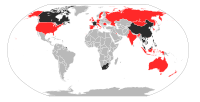
Photo from wikipedia
A novel strain of coronavirus, SARS-CoV-2, the causative agent of coronavirus disease (COVID-19) was first associated with severe acute respiratory disease in late 2019 and has triggered an ongoing pandemic… Click to show full abstract
A novel strain of coronavirus, SARS-CoV-2, the causative agent of coronavirus disease (COVID-19) was first associated with severe acute respiratory disease in late 2019 and has triggered an ongoing pandemic since March 2020 [1–3]. The pandemic has already had a serious impact on the global economy and has resulted thus far, to over 2.7 million deaths and over 122 million infections [4]. The rampage of the COVID-19 pandemic is ongoing. Meanwhile, in a world effort a number of anti-SARS-CoV-2 vaccines were developed in record time by late 2020 for emergency use. The approval of vaccines in less than a year is unprecedented in human history and a triumph in medical research [5]. The variants D614G was the first spike protein mutation of concern that spread worldwide within few months [6]. By the end of June 2020, variants D614G were found in almost all the SARS-Cov-2 samples worldwide [6]. However, the detection of mutant strains of SARS-CoV-2 in Brazil (P.1), South Africa (1.351), and the United Kingdom (UK) (B.1.1.7) have triggered huge concern around the world (Table 1) [7]. Based on available information, the highest rate of transmissibility and infection rates reported for the mutant strains of SARS-CoV-2 is the UK B.1.1.7 which has already spread to over 50 countries [8,9]. In comparison, the South African strain has spread to 20 countries [10], and the Brazilian mutant strain has spread to Japan, Germany, and some other countries [10]. The detection of the new mutant strains in many countries prompted border closures, lockdowns, and new restrictions and ultimately massive economic loss and further deaths. The UK B.1.1.7 strain is linked to higher number (>60%) of infections in the UK since its detection and is considered to be at least 50–70% more contagious than the original Wuhan strain. A recent study conducted by Imperial College London (Preprint), reported that the reproduction number (R) of B.1.1.7 is 1.45 compared to 0.92 for the original non-mutated SARS-CoV-2 virus [11]. To control a pandemic the R-value should be below 1. Very recently, there are reports for the emergence of further new variants, primarily, the New York variant (B.1.526) and the California variant (B.1.427/B.1.429) which are spreading rapidly. By mid-February 2021, B.1.526 cases had risen to 27% of viral sequences in the database. By January 2021, the California variant accounted to 53% of cases sampled. Genetic mutations of viruses is a common phenomenon, and currently, 4000 mutations in the spike protein of SARSCoV-2 have already been identified and most of them do not have any effect on the virus in regard to its ability to spread or cause disease [7]. However, the Brazilian P.1, UK B.1.1.7, and South African 1.351 mutations are dangerous as they possess features such as, escape from the immune system, bind strongly with ACE2 receptor and may cause more harm [10,14]. More specifically the UK B.1.1.7 strain has received considerable attention due to its high transmissibility rate and has been identified by a unique number and combination of mutations. Currently 17 unique mutations with the UK variant have been identified [15]. It is unclear whether mutations or combination of mutations are responsible for increased transmissibility of the UK B1.1.7 strain. In addition, it is speculated that the South African 1.351 mutant strain, has mutations located on the spike protein which helps strong binding to angiotensin-converting enzyme 2 (ACE2) and eventually contributes to higher transmission [7]. Furthermore, mutations are known to help the virus to escape the immune system or replicate more efficiently once in the host. The Brazilin (P.1) strain also contains an escape mutant known as E484K where the negatively charged (E, glutamic acid) is substituted with a positively charged amino acid (K, lysine), resulting in a new and stronger binding site of ACE and also aids the virus to escape the immune system, making it more infectious (Figure 1).
Journal Title: Expert Review of Vaccines
Year Published: 2021
Link to full text (if available)
Share on Social Media: Sign Up to like & get
recommendations!